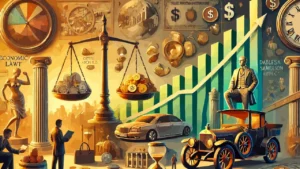The Kingdom of the Two Sicilies, which existed from 1816 to 1861, represents a significant chapter in pre-unification Italian history. The question of its relative wealth compared to the northern regions before Italian unification is a matter of debate among historians and economists. Some argue that it was a prosperous and dynamic kingdom, plundered by the North after unification, while others consider the idea of lost wealth as a historiographical myth.
In this article we will examine the economic situation of the Kingdom of the Two Sicilies before and after unification, the fate of its gold reserves and evaluate whether it was really a prosperous state that the North destroyed or whether it is a myth built over time.
Contents

#1. The Two Sicilies before unification
The Kingdom of the Two Sicilies was born in 1816 from the fusion of the Kingdoms of Naples and Sicily, under the Bourbon dynasty. With its capital in Naples, the kingdom included southern Italy and Sicily, constituting one of the largest and most populous states of the Italian peninsula. Its economy was based mainly on agriculture, characterized by strong landed estates, where large landed estates were concentrated in the hands of a few nobles and landowners. This economic structure contributed to keeping a large part of the population in poverty, generating strong social inequalities that fueled popular discontent and distrust towards the ruling class.
The size of landholdings and the lack of an equitable redistribution of resources prevented a real development of living conditions in rural areas, where the feudal system continued to strongly influence the socio-economic structure. Peasants and laborers, forced to work for very low wages, often lived in extremely precarious conditions, while the aristocracy enjoyed privileges and wealth accumulated over the centuries. This disparity, however, did not prevent the kingdom from developing some industrial and infrastructural excellences, which represented an attempt at modernization despite the backward social context.
Despite the predominance of agriculture, the Kingdom of the Two Sicilies boasted some significant industrial realities, especially in the iron working and textile sector. The Pietrarsa iron and steel complex, located near Naples, was one of the largest in Europe and represented a symbol of the economic modernization promoted by the Bourbons. Here, locomotives, railway carriages and other iron products were produced, intended to support the development of the kingdom’s infrastructure. This production hub testified to the Bourbon dynasty’s desire to make southern Italy competitive on a technological and industrial level.
At the same time, Salerno’s textile industry was renowned for the quality of its products and the high number of workers employed, so much so that it earned the nickname “Manchester of Italy”. The textile factories produced fine yarns and fabrics, intended not only for the domestic market but also for export, helping to consolidate the local economy and create stable employment. However, even in this industrial context, there were still disparities in the treatment of workers, with low wages and often difficult working conditions, a testimony to the social contradictions of the kingdom.
From a financial point of view, the kingdom had several solid banking institutions, such as the Bank of Naples and the Bank of Sicily, which managed significant gold reserves and guaranteed relative monetary stability. The presence of these financial institutions represented an important guarantee against economic crises and allowed the kingdom to maintain a certain autonomy on the international level. However, the distribution of wealth remained highly unbalanced, with a few individuals holding most of the economic resources.
The kingdom’s merchant fleet was among the most advanced in the Mediterranean, enabling trade with other European nations and ensuring a constant flow of goods and resources. Rail links, although still limited compared to other regions of Europe, represented an important step towards modernization and facilitated the transport of goods between the kingdom’s main cities. However, despite this progress, widespread poverty and the absence of effective social policies continued to characterize the daily life of the majority of the population.
Ultimately, the Kingdom of the Two Sicilies presented itself as a complex and contradictory reality, where industrial and financial modernization coexisted with widespread social backwardness and strong economic disparities. The Bourbon dynasty sought to project an image of power and progress, but social tensions and deep-rooted poverty undermined its internal stability, preparing the ground for the historical upheavals that would soon lead to the Unification of Italy.

#2. The unification of Italy
The unification of the Kingdom of the Two Sicilies was one of the most significant and controversial events of the Italian Risorgimento. This process occurred mainly through the Expedition of the Thousand, led by Giuseppe Garibaldi in 1860, but was the result of a complex combination of political, social and military factors that decreed the end of the Bourbon dynasty and the annexation to the newborn Kingdom of Italy.
The Expedition of the Thousand began on May 5, 1860 from Quarto, near Genoa, with a group of about a thousand volunteers, mostly young idealists, armed and ready to fight for the unity of Italy. Garibaldi landed in Marsala, Sicily, on May 11, finding a warm welcome from the local population, already intolerant of Bourbon rule. Thanks to a skilled military strategy and popular support, he managed to obtain a rapid victory in the Battle of Calatafimi against the Bourbon troops commanded by General Landi, who surrendered without putting up significant resistance.
One of the most surprising aspects of unification was the almost total lack of organized military resistance by the Bourbon army, despite its large size and theoretically well-equipped nature. This phenomenon was due to a series of factors, including the poor motivation of the troops and the weakness of the political and military leadership. Francis II of Bourbon, young and inexperienced, was unable to coordinate an effective defense and quickly found himself politically isolated.
Popular disaffection towards the Bourbon regime played a crucial role. Many southern communities saw Garibaldi as a liberator, a man who would bring justice and freedom in a social context characterized by profound inequalities and economic backwardness. The anti-Bourbon sentiment, already widespread among the population, favored the rapid advance of Garibaldi’s troops through Sicily and towards Calabria, without encountering significant resistance.
Another decisive factor was the corruption and disorganization within the Bourbon army. Numerous officers, demoralized or corrupt, deserted or surrendered without fighting, preferring to go over to Garibaldi’s side to ensure their future under the new regime. Furthermore, some Bourbon units openly sympathized with liberal and unitary ideas, contributing to further weakening the defensive capacity of the kingdom.
The possible role of England in the unification of Italy and the fall of the Kingdom of the Two Sicilies should not be underestimated. The English, in fact, had economic and strategic interests in the Mediterranean and looked favorably upon the creation of a strong and stable unitary state that could guarantee greater security and better management of trade. There is no shortage of evidence that suggests tacit support for Garibaldi’s expedition: for example, there is talk of British ships that guarded the Sicilian coast during the landing at Marsala, guaranteeing indirect cover for Garibaldi’s operations.
Furthermore, England had long established a network of contacts and influence in the territories of the Kingdom of the Two Sicilies, exploiting its powerful fleet and the presence of British traders and industrialists in Naples and Palermo. Some historians believe that London saw the Kingdom of the Two Sicilies as an unstable and backward entity, preferring a united Italy under the aegis of the House of Savoy rather than a Bourbon monarchy perceived as antiquated and unreliable.
Garibaldi ‘s advance continued without a hitch until Naples, where he entered on 7 September 1860 without encountering opposition. Francis II took refuge in Gaeta, where he tried to organize a desperate resistance, but the city fell on 13 February 1861, definitively marking the end of the Kingdom of the Two Sicilies.
The international context also influenced the outcome of the campaign. Although officially neutral, the Kingdom of Sardinia and some European powers, such as England, tacitly supported Garibaldi, seeing in the fall of the Bourbons an opportunity to consolidate a united and less fragmented Italy. The speed of unification was also favored by Garibaldi’s ability to arouse popular enthusiasm through effective propaganda and symbols of national redemption.
Ultimately, the unification of the Kingdom of the Two Sicilies was not only a military conquest, but also a social and political process that saw the intertwining of popular hopes, institutional weaknesses and diplomatic strategies. The fall of the Bourbons was the result of a complex intertwining of events and circumstances, where the desire for redemption and Garibaldi’s skillful strategy combined with the internal disintegration of the kingdom, sealing the fate of the South and opening a new page in the history of Italy.

#3. The Two Sicilies after unification
After the Italian unification of 1861, the Kingdom of the Two Sicilies ceased to exist as an autonomous political entity and was annexed to the Kingdom of Italy. This historical process, apparently inevitable in the context of the Risorgimento, led to profound economic and social transformations that marked the fate of the southern regions in a lasting way. The administrative and political merger with the new unitary state was not accompanied by a balanced economic integration, and this generated strong tensions between North and South.
The new unitary state imposed centralized economic policies that often favored the North, where industrialization was already underway, while the South suddenly found itself forced to face a rapid adaptation to the new economic reality. The productive structures that characterized the South, already fragile, found themselves exposed to an unequal competition with the northern industries, more modern and supported by targeted economic policies. The industrial complexes that once represented symbols of modernization, such as Pietrarsa and the textile factories of Salerno, underwent a progressive decline.
The existing industries in the South were progressively abandoned or converted, often unable to compete with those in the North, which benefited from greater investments and modern infrastructure. In some cases, closed factories and laid-off workers represented the epilogue of a productive fabric no longer capable of adapting to new market dynamics. The absence of policies aimed at the economic recovery of the South contributed to worsening the gap between the two areas of the country, consolidating a disparity that would continue to weigh for decades.
To make matters worse, the fiscal policies of the new kingdom disproportionately burdened the southern regions, often applying taxes and tributes that hit hard a population already tried by economic precariousness. This penalizing fiscal system contributed to fueling a sense of alienation and distrust towards national institutions, reinforcing the perception of a distant and unjust State. The loss of local economic prerogatives and the centralization of fiscal power in Rome generated discontent and a sense of abandonment.
From a social point of view, the impact of unification was devastating for a large part of the southern population. Many farmers and workers found themselves deprived of the previous protections guaranteed by the Bourbon regime, and had to face a new reality without concrete support. State-owned lands, once accessible to local communities, were progressively privatized, depriving many farmers of vital sources of sustenance. The increase in tax pressure and the absence of agricultural development policies contributed to further worsening living conditions in the countryside.
In this difficult context, the phenomenon of brigandage exploded as a social and political plague. Interpreted by some as a form of popular resistance against the Piedmontese “occupation”, and by others as an expression of banditry, brigandage became the symbol of a rebellious and dissatisfied South. The State’s response was a violent and often indiscriminate repression, which led to massacres and deportations of entire villages suspected of supporting the brigands. This repression helped consolidate a climate of distrust and hostility towards the new unitary state, perceived as an oppressor rather than a liberator.
The wounds left by unification remained open for many decades, fueling a historical narrative that saw the Risorgimento process as an imposition rather than a liberation. Social tensions and a sense of economic abandonment contributed to the formation of a southern identity deeply marked by a feeling of exclusion. Only in the following years, through partial and late interventions, would the Italian State try to mend the economic and social fabric of a Mezzogiorno that continued to bear the weight of a unification experienced as a conquest rather than an opportunity.

#4. The gold reserves of Two Sicilies
One of the most controversial and debated topics among historians concerns the fate of the gold reserves accumulated under the Bourbon management. At the time of Italian unification in 1861, the Kingdom of the Two Sicilies boasted one of the largest gold reserves in Europe, the result of careful financial management and a prudent monetary policy. This enormous wealth constituted a significant asset for the southern economy and an element of economic stability for the entire kingdom.
Some historians argue that, after unification, these gold reserves were largely transferred to the North to finance the debt of the newborn Kingdom of Italy and support the process of northern industrialization. This hypothesis fuels a historical narrative that interprets unification as an economic conquest rather than a real national fusion, placing emphasis on an alleged plundering of southern resources for the benefit of the richest areas of the peninsula. This theory has found fertile ground among those who see Italian unification as a cause of southern underdevelopment.
However, other historical analyses suggest that a large part of these resources remained with southern financial institutions, such as the Banco di Napoli and the Banco di Sicilia, which maintained a certain managerial autonomy even after unification. These institutions continued to operate as nerve centers of the local economy, ensuring relative monetary stability and preserving part of the resources accumulated in the Bourbon era. In particular, the Banco di Napoli still played a significant role in the financial context of the South, although the impact of the new centralized economic policies progressively reduced its importance.
Despite this, the economic situation in the South worsened dramatically in the years following unification, fueling the narrative of an intentional impoverishment perpetrated against the southern regions. The economic and social difficulties that followed the merger with the Kingdom of Italy helped consolidate the sense of historical injustice perceived by many southern communities, who attributed the responsibility for the economic decline to centralized policies. The loss of industrial competitiveness and the abandonment of productive infrastructures generated a vicious circle of impoverishment and migration towards the North or abroad.
The historical truth, as often happens, seems to be more complex and nuanced: if on the one hand some financial resources were actually used to stabilize the finances of the new unitary state and support economic consolidation, on the other hand the idea of a complete plundering of the South appears exaggerated and lacking a clear documentary basis. The financial archives and historical testimonies do not completely support the thesis of a systematic subtraction of gold and capital, but neither do they deny the perception of an imbalance in public investment policies.
It is certain, however, that the lack of investment in the South and discriminatory economic policies contributed to consolidating the economic gap between North and South, generating a fracture that would mark the history of the country for over a century. The progressive decline of the southern productive infrastructure and the political inattention to local problems determined an economic weakening that was difficult to fill in the following years. This economic gap also translated into a cultural and political distance between the two Italies, a gap that still struggles to be filled today.

#5. No “plunder” by the North
The idea that the Kingdom of the Two Sicilies was an economic paradise destroyed by unification is a thesis supported by some revisionist movements, which see the annexation to the Kingdom of Italy as an act of conquest aimed at plundering southern resources to favor northern industrialization. This interpretation, often imbued with nostalgia and resentment towards the unification process, finds fertile ground in a social context still marked by inequalities between North and South.
However, the available economic data do not fully support this view. Although the South boasted significant resources and industries, such as the steel complexes of Pietrarsa and the textile factories of Salerno, its economic system was fragile and strongly polarized between a few rich and many poor. The social structure of the Kingdom of the Two Sicilies was characterized by strong landed estates, with vast landholdings in the hands of a narrow aristocratic elite, while the vast majority of the population lived in conditions of poverty or precariousness. This imbalance constituted an intrinsic weakness of the southern economy, which made harmonious and inclusive development difficult.
The unification of Italy, while representing a fundamental historical step, undoubtedly dealt a severe blow to the southern economic system. The imposition of centralized economic policies, often calibrated to the needs of the industrialized North, did not favor the South and contributed to widening the economic gap that already existed. The fiscal pressure imposed by the new unitary State weighed heavily on the southern regions, without returning adequate infrastructural investments or local development policies. This caused a slow but inexorable decline of many economic activities, which struggled to compete with northern production.
At the same time, attributing all the blame to the North would be an unfair and reductive simplification. The economic decline of the South was already underway before unification, due to structural weaknesses and a backward economic system, unable to adapt to the rapid changes that were transforming 19th-century Europe. The scarcity of technological innovation, combined with the lack of modernization policies, had already placed the South at a disadvantage compared to the more advanced regions of the continent.
The narrative of a prosperous and flourishing South, suddenly plundered by the North, therefore appears more like a romantic myth than an absolute historical truth. While acknowledging that some resources were transferred to the North to stabilize the finances of the newborn Kingdom of Italy, the idea of a complete plunder is poorly based on concrete documentary evidence. In reality, the South already suffered from profound economic and social fragilities, further aggravated by a centralized management that did not take into account local peculiarities.
After unification, the lack of a strategic plan for the economic recovery of the South helped crystallize the gap between the two areas of the country, but this does not mean that the South was initially a model of prosperity destroyed by an external invasion. On the contrary, the socioeconomic context of the Kingdom of the Two Sicilies already showed signs of crisis and backwardness, even if there were local excellences that were trying to emerge.
In conclusion, the vision of a happy and prosperous South, destroyed by predatory post-unification policies, is more a myth constructed a posteriori than an objective historical reality. The truth is that unification was inserted into an already complex and problematic framework, accentuating dynamics of imbalance but without being the only cause. The history of Southern Italy is, in fact, an intertwined story of failed modernization, questionable political choices and deep-rooted social dynamics, in which national unity represented an epochal challenge rather than a definitive ruin.







Leave a Reply